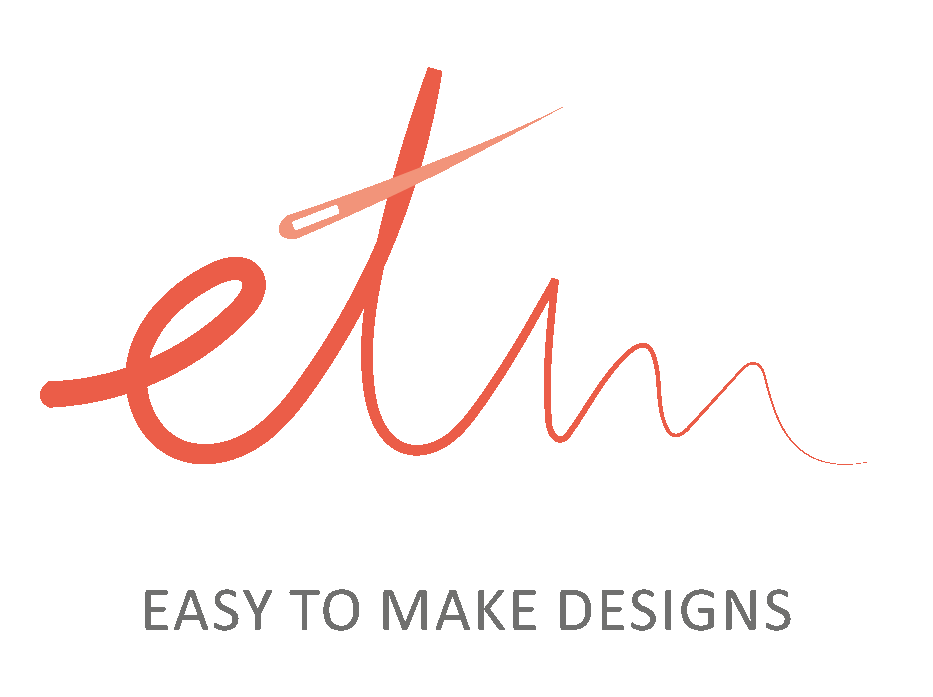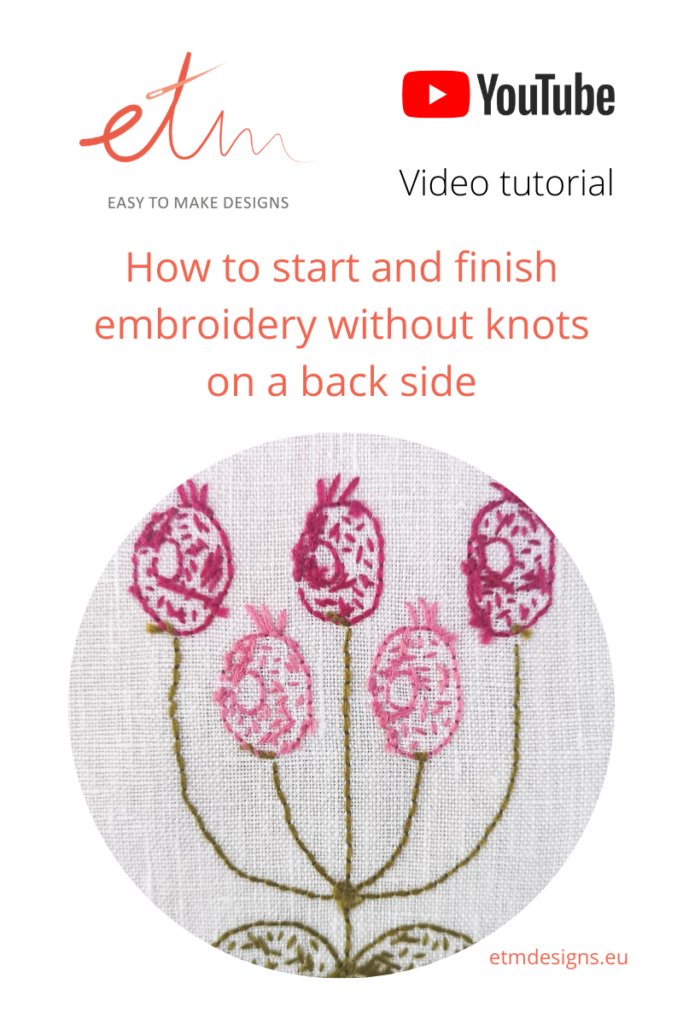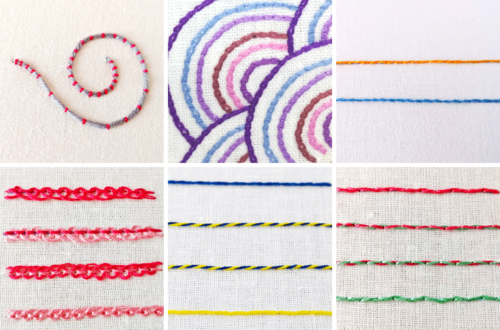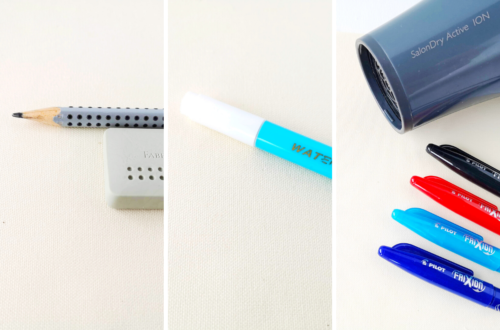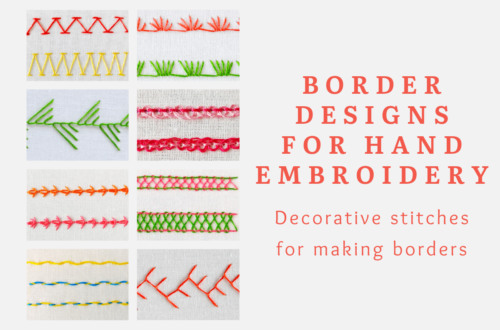
Starting and finishing to stitch in hand embroidery secrets revealed
You can see a lot of hand embroidery tutorials on the internet, but how do they start and finish to stitch? Usually, it remains a secret. In hand embroidery, there are many different ways to start stitching and finish the stitch. Your choice will depend on what kind of stitches you will use and if you will cover the area where you start and finish embroidering with stitches later or not. Although almost no one will see your holding stitches, it might be your most important stitch. Make it right and you will be safe in the knowledge that all your hard work is secure.
Let’s reveal the secrets of starting and finishing embroidery and explore all the possibilities.
If you prefer to watch video tutorial instead of reading – check out this link.
Simple knot on the back of the fabric
How to do it? Thread your needle and tie a little knot at the end of your thread. Start embroidering, leaving the knot on the back side of your embroidery. That’s it. Though it might be the most simple and right choice, it’s not and I really don’t recommend this method for starting your stitches.
Pros:
- Making a knot is a simple and fast way to start embroidering
- With a knot, you don’t need any additional stitches to secure the thread
- There is no wasting of thread
Cons:
- With the time, knots get looser and you risk that your embroidery will start to fall apart, especially if you wash your embroidered piece
- Knots may be visible from the front side, especially if the material is thinner and the thread is dark
- Even on the thicker material, knots can be visible as tiny bumps
- If you embroider on clothes, knots on the inner side may irritate the skin
- Knots don’t look good and will make the back of your embroidery look messy and unprofessional
Making a holding stitch
Holding stitch is a series of small stitches that are made to secure the thread on fabric without making a knot. Holding stitches are made either on the line or within the shape you are filling so that it will lie under the stitching.
How to do it? Knot the end of the thread and take the thread down through the fabric from the top. Pull the thread through, then bring the needle up just behind the knot, either on the line or within the shape you are filling, so that it will lie under the subsequent stitching. Then, pull the thread through and make two tiny stitches close by. Bring the needle up where you wish to start and cut off the knot close to the fabric.
Pros:
- Holding stitches are invisible after you cover them with the stitch or filling
- You need just a little bit of additional thread to make these tiny stitches
- You get a smooth surface of the stitch on both sides of the embroidery
Cons:
- It is impossible to make holding stitches if your design doesn’t include filled areas or the stitches you use can not cover holding stitches (like running stitch of french knots)
Starting embroidery with a folded thread
How to do it? To start your stitching this way you will need a thread twice as long as you would normally use. Cut one long strand of floss and fold it in half. Thread the cut ends into the eye of the needle, with the folded end last. Push your needle from the back to the front of the fabric as you normally would, only don’t pull the thread all the way through. Leave a small loop on the back of the fabric. On the front of the fabric, make a stitch — but before you pull the needle and thread through, turn the fabric over again and pass the needle through the loop. Pull the needle through the loop and tighten the thread. This will create a chain stitch around the working thread. Turn the fabric over and continue stitching. Your thread is secured to the back of the fabric with no knot.
Pros:
- The starting point of your stitch will be invisible
- There is no wasting of thread
- No additional steps or stitches required
Cons:
- This method can be used only if you are using a paired number of threads
- This starting method requires that either the first formation of your stitch is a straight stitch, or that you work a straight stitch to anchor the thread and then stitch over it with other stitches
Waste away knot
It is called so because you will eventually cut off the knot that you start with. This technique works with any type of thread and any number of strands and any kind of stitches.
How to do it? Start with your fabric up, a knot at the end of your thread, and take your needle down into your fabric from the top like 10-12 cm (at least 3 inches) away from the point you intend to start stitching so that your knot is on top of your fabric. Take the needle up at the starting point of your embroidery. Make sure the path between the knot and where you’re starting isn’t in line with your stitching. Make all of your stitches and secure the end. Then pull up on the knot, and snip it close to the fabric. You will see a loose thread on the back of the stitching. Thread this thread back onto your needle and passing under the back of the stitches, wrap your threads on the back of the stitches to secure them, the same way you would anchor the end of the stitching.
Pros:
- Waste away knot is invisible after you secure the loose thread
- It will work with almost any type of stitches
Cons:
- You have to take care of every cutaway knot immediately, as otherwise it will get tangled under subsequent stitches and the back of your embroidery will become a mess
- It’s wasteful. You will need an extra 10- 12 cm of a thread for every stitch started this way
Anchoring your stitches to the previously made stitches
If you already embroidered your first shape and you need to continue with another kind of stitches or in different colors (or your thread is finished), you can anchor your new stitches to the ones already made.
How to do it? Turn over your hoop as you will start working from the back side of the embroidery. Take your threaded needle under the stitches of previously embroidered shape at about 2 cm (half an inch) away from the point you will start your new stitches. Back stitch over the thread you went under, and then continue threading your needle under the line of stitches, until you’ve reached your starting point. Then pull the needle through to the right side of embroidery and start your new shape or color.
Pros:
- This method is very simple
- The starting point will be invisible from the front side
- This method does not require any additional stitches or extra thread
Cons:
- This method can be used only if the new stitches are connected with previously made ones
Ending embroidery thread with anchoring
This method of ending threads will work with practically any kind of stitch.
How to do it? Once you’re ready to end your thread, take your needle to the back of the fabric (with the last stitch) and turn your work over. Run your needle under the back of two or three stitches. Back stitch over the last thread you went under and then continuing threading your needle under the line of stitches until you’ve about covered your needle. Then pull the needle through and cut off the thread.
Ending embroidery with holding stitch
If you are making embroidery with many covered areas, you can end your thread with holding stitches.
How to do it? When you finish stitching, make two tiny stitches at the end in the area that will be covered later, bring the thread through to the top of the fabric and cut it off close to the fabric. Subsequent stitches will cover those small stitches and will secure your embroidery.
What’s next?
“For the things we have to learn before we can do them, we learn by doing them.”
― Aristotle
You’ll have to try all of the ways to start and finish embroidering before you will find your best one. And you will have to practice it for some time before you’ll become really good at it. After you do that, you will never want to come back to the simple knot on the back side of your embroidery, I promise you.
If you need some visual guidance in trying all the methods of starting and finishing the thread, watch this video tutorial in my YouTube channel.
Don’t have an embroidery project in mind yet? Check out my embroidery patterns in the shop and maybe you will find one just right for you!
Keep stitching and remember that anything is easy to make, if you know how!


